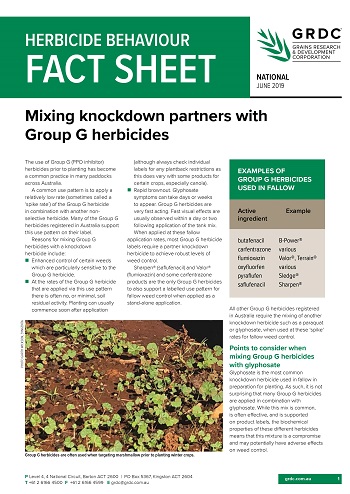Mixing knockdown partners with Group G herbicides
Mixing knockdown partners with Group G herbicides
Published: 17 Jun 2019
The use of Group G (PPO inhibitor) herbicides has increased in recent years as users are looking to put more diversity into their fallow weed control programs. Most Group G herbicides require the addition of a non-selective knockdown partner when used in fallow or pre-sowing. Most commonly the choice of partner herbicide is a decision between either glyphosate or a paraquat based herbicide.
Glyphosate, a systemic herbicide that takes time to enter and translocate throughout the weed, may not always be the ideal mixing partner for a fast-acting Group G contact herbicide that has limited ability to translocate within the weed. Where glyphosate is to be mixed, it is important to understand compromises that are being taken in terms of herbicide application and the potential impact on weed control. This fact sheet discusses some of the considerations in selecting the choice of tank mix partner for Group G herbicides in fallow.
Key points
While glyphosate is often used successfully with Group G herbicides in fallow or prior to planting, there may be some compromises with this mixture.
Situations where less concern arises:
- Where the efficacy of the Group G is doing the primary weed control, so reduction in glyphosate translocation is of less importance.
- Very small weeds with no significant stored root reserves, where a low rate of glyphosate translocating within the first few hours after application is adequate to achieve control.
Areas of more concern arise where:
- Weeds where glyphosate is providing the majority of the efficacy (especially grass weeds).
- Robust rates of Group G are applied, resulting in fast damage to the plants vascular bundle.
- Glyphosate resistance is present.
- An oil-based adjuvant is used that will increase the speed of activity of the Group G and also may detrimentally affect the adjuvant system for glyphosate.
- Less effective surfactant systems are used for the glyphosate component, reducing the speed of glyphosate penetration and translocation.
Useful resources
Congreve, M. and Cameron, J. (2018). Understanding post-emergent herbicide weed control in Australian farming systems - a national reference manual for agronomic advisers. GRDC publication, Australia. https://grdc.com.au/understanding-post-emergent-herbicide-weed-control
Further information
Further research on interactions between glyphosate and PPO inhibitor herbicides can be found in these international research papers.
Ashigh and Hall (2010) Bases for interactions between saflufenacil and glyphosate in plants. J. Agric. Food Chem. 58 (12):7335-7343 https://pubs.acs.org/doi/10.1021/jf100595a
Eubank et. al. (2013) Saflufenacil efficacy on horseweed and its interaction with glyphosate. Weed Biology and Management. 13(4):135-143 https://onlinelibrary.wiley.com/doi/abs/10.1111/wbm.12022
Gizotti de Moraes (2018) Evaluation of glyphosate and PPO-inhibiting herbicide tank-mixtures to manage glyphosate resistance in soybean. University of Nebraska - Lincoln. http://digitalcommons.unl.edu/agronhortdiss/147
Starke and Oliver (1998) Interaction of glyphosate with chlorimuron, fomesafen, imazethapyr and sulfentrazone. Weed Science 46:652-660 https://www.jstor.org/stable/4045915
Wehtje, Gilliam and Marble (2010) Postemergence weed control with glyphosate plus flumioxazin combinations. Weed Technology 24(3):356-360. https://www.jstor.org/stable/40801448
Nandula et. al. (2012) Multiple resistance to glyphosate and pyrithiobac in Palmer amaranth (Amaranthus palmeri) from Mississippi and response to flumiclorac. Weed Sci 60:179–188 https://www.researchgate.net/publication/261979705_Multiple_Resistance_to_Glyphosate_
and_Pyrithiobac_in_Palmer_Amaranth_Amaranthus_palmeri_from_Mississippi_and_Response_to_Flumiclorac
Download PDF
Region: National
GRDC Project Code: ICN1811-001STX,

